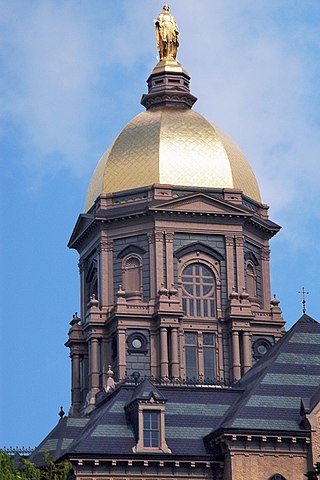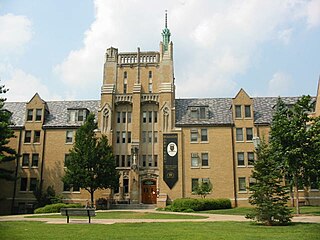
The University of Notre Dame du Lac, known simply as Notre Dame, is a private Catholic research university in Notre Dame, Indiana, north of the city of South Bend. French priest Edward Sorin founded the school in 1842. The main campus covers 1,261 acres in a suburban setting and contains landmarks such as the Golden Dome, the Word of Life mural, Notre Dame Stadium, and the Basilica. Originally for men, the university did not formally accept undergraduate female students until 1972.

Keenan Hall is one of the 32 Residence Halls at University of Notre Dame. It is located on North Quad in front of North Dining hall, between Zahm Hall and Stanford Hall. Keenan Hall shares the building and The Chapel of The Holy Cross with adjacent dorm Stanford

Alumni Hall is one of the 32 Residence Halls on the campus of the University of Notre Dame and one of the 16 male dorms. It is located on South Quad adjacent to "Main Circle", across from the law school building, and it hosts 234 undergraduates.


St. Edward's Hall is one of the 32 Residence Halls on the campus of the University of Notre Dame and one of sixteen male dormitories. Saint Edward's Hall is located directly east of the Main Administration Building and is directly west of Zahm Hall and houses 162 undergraduate students. The dorm community and culture are not as old as Sorin College (1888) as it was established as an undergraduate residence hall 30 years later. However the building itself was built in 1882 to house the minims, Notre Dame's boarding school program. When such program was discontinued in 1929, the building was converted to an undergraduate residence hall, which it has been ever since. Together with other historical structures of the university, it is on the National Register of Historic Places. The coat of arms is the Cross of Saint Edward the Confessor on a green background.

Sorin Hall, also known as Sorin College, is the oldest of the 32 Residence Halls on the campus of the University of Notre Dame and one of the 17 male dorms. It is named after Fr. Edward Sorin, C.S.C., the founder of Notre Dame. Sorin is located directly north of Walsh Hall and is directly south of the Basilica of the Sacred Heart. Sorin houses 143 undergraduate students. Sorin Hall is, along with other buildings on the Main Quad of Notre Dame, on the National Register of Historic Places. Sorin Hall was the first Notre Dame residential hall established as such, although St. Edward's Hall is housed in an older building.

Walsh Hall is one of the 32 Residence Halls on the campus of the University of Notre Dame. Walsh is located on Main ("God") Quad, directly south of Sorin Hall and is directly north of the Knights of Columbus Building. It was built in 1909 and the architect was William J. Brinkmann. Among other buildings on the Main Quad of Notre Dame, Walsh Hall is on the National Register of Historic Places. The coat of arms is taken from the Walsh family.

Dillon Hall is one of the 32 Residence Halls on the campus of the University of Notre Dame and one of the 16 male dorms. It is located directly west of Alumni Hall and is directly adjacent to South Dining Hall on the west. Dillon was built in 1931 and renovated for the 2020-2021 school year and many of the first floor rooms were converted to living and study areas. It is named after Patrick Dillon, CSC, the second president of the university. The coat of arms is taken from the Dillon family. Together with other historic structures of the university, it is on the National Register of Historic Places.

Badin Hall is one of the 32 Residence Halls on the campus of the University of Notre Dame and one of the 14 female dorms. The smallest residence hall on campus, it is located on South Quad, between Howard Hall and the Coleman-Morse center. It was built in 1897 and hosted the Manual Labor School until 1917 before being converted into a men's dorm. During World War II, it was part of the United States Naval Reserve Midshipmen's School, and in 1972 it became one of the first two residence halls at Notre Dame to host women.

Howard Hall is one of the 32 Residence Halls on the campus of the University of Notre Dame and one of the 14 female dorms. It is located north of South Dining Hall on University of Notre Dame's South Quad, and is immediately surrounded by Badin Hall on the east, Morrissey Manor on the west, and Bond Hall on the north. Built in 1924–1925, it is dedicated to Timothy Edward Howard, and hosts 145 undergraduates. The coat of arms is based on that of the Howard family adapted to fit Howard Hall, changed to match those of the hall, and the lions were substituted with ducks.
There are currently 33 undergraduate residence halls at the University of Notre Dame, including 32 active residence halls and Zahm Hall, which serves as a transition dorm when residence halls undergo construction. Several of the halls are historic buildings which are listed on the National Register of Historic Places. Each residence hall is single-sex, with 17 all-male residence halls and 15 all-female residence halls. Notre Dame residence halls feature a mixed residential college and house system, where residence halls are the center of the student life and some academic teaching; most students stay at the same hall for most of their undergraduate studies. Each hall has its own traditions, events, mascot, sports teams, shield, motto, and dorm pride. The university also hosts Old College, an undergraduate residence for students preparing for the priesthood.

University of Notre Dame's Main Administration Building houses various administrative offices, including the office of the President. Atop of the building stands the Golden Dome, the most recognizable landmark of the university. Three buildings were built at the site; the first was built in 1843 and replaced with a larger one in 1865, which burned down in 1879, after which the third and current building was erected. The building hosts the administrative offices of the university, as well as classrooms, art collections, and exhibition spaces. The building is listed on the National Register of Historic Places.

Morrissey Hall is one of the 32 Residence Halls on the campus of the University of Notre Dame and one of the 16 male dorms. Built in 1925-1926, its architects were Vincent Fagan and Francis Kervick. Along with other buildings on Notre Dame's campus, it is on the National Register of Historic Places. It is referred to as Morrissey Manor by its residents.

Zahm Hall, also known as Zahm House, is a University of Notre Dame residence hall. The building was constructed in 1937 and is located directly east of St. Edward's Hall and is directly west of North Quad. Starting with the 2021-2022 school year, Zahm Hall hosts communities of residents whose halls are being renovated, starting with Sorin Hall.

The campus of the University of Notre Dame is located in Notre Dame, Indiana, and spans 1,250 acres comprising around 170 buildings. The campus is consistently ranked and admired as one of the most beautiful university campuses in the United States and around the world, particularly noted for the Golden Dome, the Basilica and its stained glass windows, the quads and the greenery, the Grotto, Touchdown Jesus, its collegiate gothic architecture, and its statues and museums. Notre Dame is a major tourist attraction in northern Indiana; in the 2015–2016 academic year, more than 1.8 million visitors, almost half of whom were from outside of St. Joseph County, visited the campus.

The LaFortune Student Center serves as one of two student centers at the University of Notre Dame. Commonly known as "LaFortune" or "LaFun," it is a 4-story building of 83,000 square feet that provides the Notre Dame community with a meeting place for social, recreational, cultural, and educational activities. The building also houses restaurants from national restaurant chains. As of 2008, LaFortune employs 35 part-time student staff and 29 full-time non-student staff and has an annual budget of $1.2 million. Many businesses, services, and divisions of The Office of Student Affairs are found within.
The Rev. Matthew J. Walsh, C.S.C. was an American priest and President of the University of Notre Dame from 1922 to 1928, after having served has Vice President 1912–22.

Johnson Family Hall is one of the 33 residence halls at the University of Notre Dame. It is located east of Dunne Hall and north of McCourtney Hall in the East Quadrangle. It is the newest residence hall, built in 2019-2020, after a donation from Todd & Susan Johnson. Its mascot is the valkyrie, and its colors are navy and light blue. It was opened during the COVID-19 pandemic in 2020.

Breen-Phillips hall is one of the 32 Residence Halls on the campus of the University of Notre Dame and one of the 14 female dorms. Breen-Phillips is on North Quad, between Farley Hall, Geddes Hall, and the Hesburgh Library. Established in 1939, it hosts 200 students.

Carroll Hall is one of the 33 Residence Halls on the campus of the University of Notre Dame and one of the 16 male dorms. Carroll is located on the shores of St. Mary's Lake, and is the smallest of the residence halls, housing around 100 undergraduates.
























